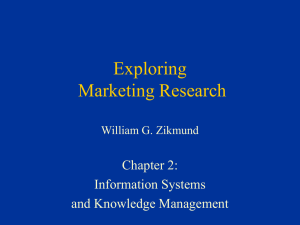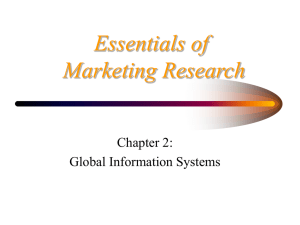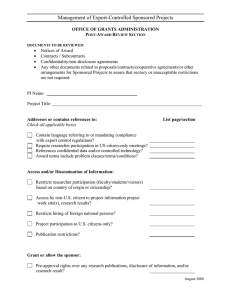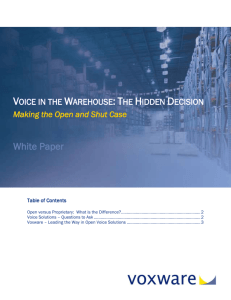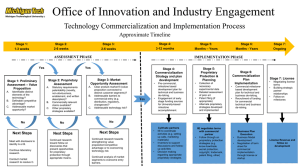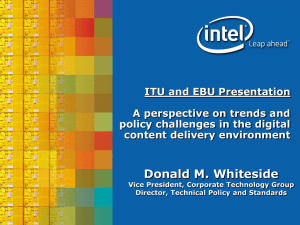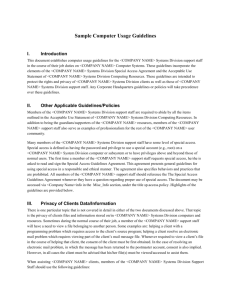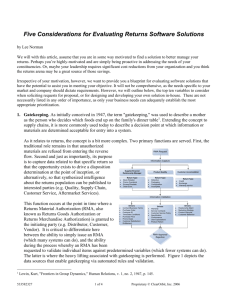The Momentum of Knowledge Management
advertisement
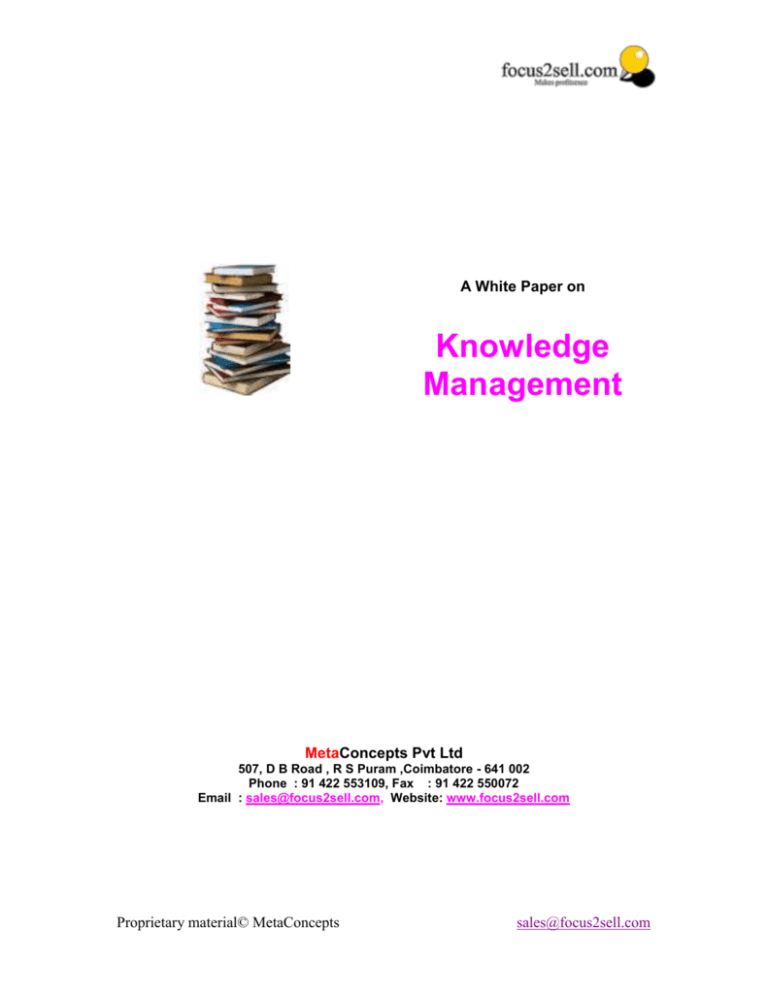
A White Paper on Knowledge Management MetaConcepts Pvt Ltd 507, D B Road , R S Puram ,Coimbatore - 641 002 Phone : 91 422 553109, Fax : 91 422 550072 Email : sales@focus2sell.com, Website: www.focus2sell.com Proprietary material© MetaConcepts sales@focus2sell.com The Momentum of Knowledge Management Knowledge Management- Introduction What began almost 10 years ago - Knowledge Innovation® has now reached the stage of a critical mass of insight. Dedicated expertise across all disciplines are exploring and defining new management practices fundamental to capitalizing upon the knowledge-based economy. Although there has been a plethora of articles and books on the topic, the seminal cook-book (if there ever be such a thing) is only 'work-in-process.' In the 1950's when Alfred Sloan divisionalized General Motors, it sent a clear, consistent, concise message of the techniques necessary for large-scale business management. However, today - driven by the acceleration of computer/communications technology and the value of collaborative networks, the real the competitive differentiator - human talent - provides the enterprise advantage. Today, there is an emerging 'community of practice' which transcends any function, sector, industry or geography. Participants include theorists and practitioners from education/learning systems, economics/finance, quality/benchmarking, human resources, information/internet technology and R&D/innovation strategy and more. The concurrent engineering, agile manufacturing and reengineering initiatives are all coming to a common theme: transformation of the enterprise - profit or not-for-profit through knowledge management. The first conference in the United States which focused upon knowledge - beyond the theories of artificial intelligence - was entitled "Managing the Knowledge Asset into the 21st Century." It was convened by Digital Equipment Corporation and the Technology Transfer Society at Purdue University in 1987. The second on "Knowledge Productivity" was coordinated by Steelcase North America and EDS in April of 1992. The third was hosted by the Industrial Research Institute (IRI) in Vancouver, British Columbia in October, 1992. McKinsey and Company initiated their Knowledge Management Practice during the same timeframe. "The Knowledge Advantage Colloquium" was co-sponsored by the Strategic Leadership Forum and the Ernst & Young Center for Business Innovation in 1994. This Fall alone, there have been a half dozen major conferences on the topic - including the three contrasted for this report. Several more planned for the Spring. Proprietary material© MetaConcepts sales@focus2sell.com Why we need knowledge management now Why do we need to manage knowledge? Ann Macintosh of the Artificial Intelligence Applications Institute (University of Edinburgh) has written a "Position Paper on Knowledge Asset Management" that identifies some of the specific business factors, including: 1. Marketplaces are increasingly competitive and the rate of innovation is rising. 2. Reductions in staffing create a need to replace informal knowledge with formal methods. 3. Competitive pressures reduce the size of the work force that holds valuable business knowledge. 4. The amount of time available to experience and acquire knowledge has diminished. 5. Early retirements and increasing mobility of the work force lead to loss of knowledge. 6. There is a need to manage increasing complexity as small operating companies are trans-national sourcing operations. 7. Changes in strategic direction may result in the loss of knowledge in a specific area. To these paraphrases of Ms. Macintosh’s observations we would add: 1. Most of our work is information based. 2. Organizations compete on the basis of knowledge. 3. Products and services are increasingly complex, endowing them with a significant information component. 4. The need for life-long learning is an inescapable reality. In brief, knowledge and information have become the medium in which business problems occur. As a result, managing knowledge represents the primary opportunity for achieving substantial savings, significant improvements in human performance, and competitive advantage. Collective findings are emerging: 1. The knowledge movement is pervasive. Whether it is defined in terms of learning, intellectual capital, knowledge assets, intelligence, know-how, insight or wisdom, the conclusion is the same: manage it better or perish. Initiatives in industry, education and government are trying to tackle the same problems, issues and opportunities. Proprietary material© MetaConcepts sales@focus2sell.com 2. The unmeasurable must be measured. If it cannot be measured, it isn't considered of value. However, traditional financial accounting mechanisms fail to calculate/calibrate the most important resources of the firm its intellectual capacity. Instead, current mechanisms treat people as liabilities or expenses instead of assets. The business case must be defined in order to justify necessary investment strategies in the human and social (i.e., interactive) capital of the firm. 3. A collaborative research base must be established There is minimal research activity for service functions or the services industry of the economy. There is no equivalent to the Industrial Research Institute for the services industry - the fastest growing sector of the economy. There is minimal government funding and few consortia which are nonindustrial in mission. Enterprises are embarking upon individual R&D efforts when a collective degree of research on a pre-competitive basis - is essential for establishing a solid foundation for the future of the industry. 4. Initiatives must be designed as 'middle-up-down.' Top down leadership continues to be essential for management because traditional hierarchical structures will not disappear overnight. Grass roots activities which are networked can have the insight for change validated by those closest to the point-of-sale. Oftentimes, those closest to service delivery are not the people empowered in an organisation. Hubert Saint-Onge, Canadian Imperial Bank of Commerce, describes the strategy as middle-up-down as a way to balance and integrate the best of both methods. 5. Insight is being gleaned rapidly. For those who embrace change as reality, there is little time to be spent on barriers. The future is far more exciting to create. In each profession, those who were deemed philosophers and futurists are being sought for counsel on business operations. What was theory yesterday is fundamental to business survival tomorrow. There is a cumulative effect between and among disciplines as leaders seek to understand the principles and policies of one another. Indeed, the field has become sufficiently sophisticated to warrant the benchmarking of best practices for even further dissemination and leverage. 6. Implementation takes many forms. The variety of new titles and program initiatives vary company-to-company due to the uniqueness of each corporate culture. New titles range from novel verbiage to relabeling of traditional functions. There are many ways to (re)configure the knowledge puzzle and leadership can come from any level, function or position in the company. Proprietary material© MetaConcepts sales@focus2sell.com 7. Management architectures are useful, but should not be limiting. A frame of reference is essential in order to scrutinize and interconnect the variables. However, exploration of the factors leads to identification of new variables and interconnections which are fundamental to the business. The frame provides a way to organize the discussion and fuse the diverse values within the company culture. The process must be dynamic - not static - in order to capitalize upon new business opportunities coming from unserved markets and unarticulated needs. 8. The nature of 'the collective' must be understood and harnessed. Enterprises are now defined as including multiple stakeholders: suppliers, partners, alliances, customers and in some cases - competitors. These infrastructures are a combination of evolving, ecological systems and carefully architected schemes for profitable growth. The combination is what is of most value. Attention must now focus upon the definition of the whole and the interconnections of the pieces. 9. Technology is integral to the successful functioning of the knowledge enterprise - but how? Similar to the misconceptions of computer-based education, artificial intelligence and the early renditions of groupware, there is confusion as to the appropriate role for the supporting technology. The 'productivity paradox' explains why there has not been a commensurate economic return for the investment on technology investments (i.e, behavioral disconnects), but it does not provide a path forward for the ideal technical solutions. This will take some time and considerable trial-anderror. 10. The knowledge phenomenon must be managed and not left to serendipity. As incomplete as the systems might be, some influence and control is better than none at all. Consider the kaleidoscope which when moved in small degrees changes the image; but there are the inevitable unexpected forces which cause a major shift in orientation. Management must be understood as both a science and an art in order to reap optimal advantage. Conclusions The interest generated over the past year is significant. Business schools have created interdisciplinary initiatives by necessity. Industrial investments have forged connections which were not likely to occur otherwise. Government agencies are also, by necessity, forced to produce significantly more results to the consumer than can be provided with incremental improvements. Re-engineering and Proprietary material© MetaConcepts sales@focus2sell.com quality efforts - along with massive restructuring - have produced what financial results are possible. Considerable alignments are now needed in order to fulfill expectations of stakeholders. The paradigm must shift. It is inevitable. This new focus upon knowledge as the foundation for a successful future has been embraced. Creativity is being reborn in ways to contribute to the bottom-line of an enterprise. As impure as this new science may be, it provides insights not easily discerned with traditional management methodologies. Experimentation is rampant and people seek to learn from their mistakes as well as the successes and failures of others. The conferences attended have all created some form of evaluation tool(s) as a way to move the dialogue forward. All have sought to learn - some in more systematic ways than others - from their participants. There is a realization that this is, indeed, a journey; and that no one has the answers. This is a movement born within industry - not the academic corridors or even the consulting firms. In fact, those parties are playing catch-up trying to determine their own role in this emerging economy. One attendee commented "The universities are a decade behind; the consulting firms are half that. Industrialists are creating the future real-time." The knowledge movement is shaking the very foundation of how an organisation is created, evolves and matures, dies or is reformed. These are fundamental shifts in the way we do business, how economies are developed and societies prosper. Where do we stand at the moment, and where do we go from here? We conclude with a thought from Bo Newman, via email: As attested to in numerous articles in the popular press, knowledge management has already been embraced as a source of solutions to the problems of today’s business. Still it has not been easy for this "science" to construct for itself that royal road of self validation. On the contrary, I believe that it is still, at least for the majority of the practitioners and their customers, in the stage of blind grouping after its true aims and destination. Enough said … for the moment. Let’s change the end of this story. Proprietary material© MetaConcepts sales@focus2sell.com

